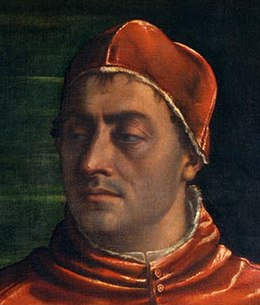| War of the League of Cognac | |||||||
|---|---|---|---|---|---|---|---|
| Part of theFrench–Habsburg rivalry andItalian Wars | |||||||
 Siege of Florence, 1530, fought during the War of the League of Cognac | |||||||
| |||||||
| Belligerents | |||||||
Pro-Habsburg:
| League of Cognac:
Supported by:  England England | ||||||
| Commanders and leaders | |||||||
TheWar of the League of Cognac (1526–1530) was fought between theHabsburg dominions ofCharles V—primarily theHoly Roman Empire andSpain—and the League of Cognac, an alliance including theKingdom of France,Pope Clement VII, theRepublic of Venice, theKingdom of England, theDuchy of Milan, and theRepublic of Florence.
Shocked by the defeat of theKingdom of France in theItalian War of 1521, PopeClement VII, together with theRepublic of Venice, began to organize an alliance to driveCharles V from theItalian Peninsula.Francis I, having signed theTreaty of Madrid, was released from his captivity in Madrid and returned to France, where he quickly announced his intention to assist Clement. Thus, on 22 May 1526, the League of Cognac was signed in the town ofCognac, France by Francis, Clement, Venice, Florence, and theSforza ofMilan, who desired to throw off the Imperial hegemony over them.Henry VIII of England, thwarted in his requests to have the treaty signed in England, refused to join.[1]
The League quickly seized the town ofLodi, but Imperial troops marched into Lombardy and soon forced Sforza to abandon Milan.[2] Meanwhile, the powerfulColonna family organized an attack on Rome to exploit the Papacy's moment of weakness, defeating the Papal forces and briefly seizing control of the city in September 1526. They were soon paid off and left the city.[3]
Charles V now gathered a force of 14,000 Germanlandsknecht mercenaries and 6,000 Spanishtercio soldiers led byGeorg Frundsberg andCharles of Bourbon; the forces combined atPiacenza and advanced on Rome.Francesco Guicciardini, now in command of the Papal armies, proved unable to resist them;[4] and when the Duke of Bourbon was killed, the underpaid armiessacked the city, forcing the Pope to take refuge atCastel Sant'Angelo. His escape was made possible by the Swiss Guards'last stand.[citation needed]
The looting of Rome, and the consequent removal of Clement from any real role in the war, prompted frantic action on the part of the French. On 30 April 1527, Henry VIII and Francis signed the Treaty of Westminster, pledging to combine their forces against Charles. Francis, having finally drawn Henry VIII into the League, sent an army underOdet de Foix andPedro Navarro, Count of Oliveto throughGenoa—whereAndrea Doria had quickly joined the French and seized much of the Genoese fleet—toNaples, where it proceeded to dig itself in for an extendedsiege.[5]
Doria, however, soon deserted the French for Charles. The siege collapsed as plague broke out in the French camp, killing most of the army along with Foix and Navarro. Andrea Doria's offensive in Genoa (where he soon broke the blockade of the city and forced the surrender of the French atSavona), together with the decisive defeat of a French relief force underFrançois de Bourbon, Comte de Saint-Pol at theBattle of Landriano, ended Francis's hopes of regaining his hold on Italy.[6]


Following the defeat of his armies, Francis sought peace with Charles. The negotiations began in July 1529 in the border city ofCambrai; they were conducted primarily between Francis's motherLouise of Savoy for the French and her sister-in-lawMargaret of Austria for her nephew the Emperor (leading to its being known as thePaix des Dames, Peace of the Ladies), Charles himself having sailed fromBarcelona to Italy shortly before. The final terms largely mirrored those of the Treaty of Madrid three years earlier; Francis surrendered his rights toArtois,Flanders, andTournai, and was obliged to pay a ransom of two million goldenécus before his sons were to be released.[7] Removed, however, were both the humiliating surrender ofBurgundy itself and the various points dealing with Charles de Bourbon, who, having been killed two years prior, was no longer a candidate for leading an independent Kingdom of Provence.[8] The finalTreaty of Cambrai, signed on 3 August, removed France from the war, leaving Venice, Florence, and the Pope alone against Charles.
Charles, having arrived in Genoa, proceeded toBologna to meet with the Pope. Clement absolved the participants of the sack of Rome and promised to crown Charles. In return, he receivedRavenna andCervia; cities which the Republic of Venice was forced to surrender—along with her remaining possessions inApulia—to Charles in exchange for being permitted to retain the holdings she had won atMarignano.[9] Finally, Francesco was permitted to return to Milan—Charles having abandoned his earlier plan to place Alessandro de' Medici on the throne, in part due to Venetian objections—for the sum of 900,000scudi.[10]
This sectiondoes notcite anysources. Please helpimprove this section byadding citations to reliable sources. Unsourced material may be challenged andremoved.(August 2025) (Learn how and when to remove this message) |

TheRepublic of Florence alone continued to resist the Imperial forces, which were led by thePrince of Orange. A Florentine army underFrancesco Ferruccio engaged the armies of the Emperor at theBattle of Gavinana in 1530, and, although the Prince of Orange himself was killed, the Imperial army won a decisive victory and theRepublic of Florence surrendered ten days later.Alessandro de' Medici was then installed as Duke of Florence byPope Clement VII, and from then on Florence became a hereditary realm of the powerful Medici dynasty, ending centuries of republican rule.
{{cite book}}:ISBN / Date incompatibility (help)